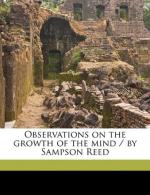|
This section contains 325 words (approx. 2 pages at 300 words per page) |
Dictionary of Literary Biography on Sampson Reed
Sampson Reed (10 June 1800-8 July 1880), druggist and proponent of Swedenborgianism in the United States, was born in West Bridgewater, Massachusetts. After graduation from Harvard College in 1818, Reed entered the Divinity School where his roommate, Thomas Worcester, introduced him to the mystical writings of Emanuel Swedenborg. Reed was so taken with Swedenborg's thought that the resulting conflict with rational Unitarianism forced him to leave the Divinity School. After receiving a Master of Arts degree in 1821, Reed became a clerk in the shop of a Boston apothecary, later opened his own shop, and eventually built one of the largest wholesale drug businesses in New England. But Reed's foremost concern was the establishment of the Swedenborgian Church in the United States. He supported his beliefs with his prolific writings which appeared in the Swedenborgian New Jerusalem Magazine and in a children's magazine he founded in 1843, The New Church Magazine for Children (later the Children's New-Church Magazine ). He died in Boston. Reed is primarily remembered today for the influence two of his compositions had upon Ralph Waldo Emerson. The oration on "Genius" (which circulated in manuscript and was belatedly printed in Elizabeth Peabody's Aesthetic Papers in 1849), delivered by Reed upon receiving his Master's degree, is one of the first indictments of Lockean sensualism in the Unitarian Church. Observations on the Growth of the Mind (Boston: Cummings, Hilliard, 1826) remains Reed's single most important work because its ideas serve as the basis of the Transcendental aesthetic theory. In this work Emerson found the ideas that each person has his own "peculium" or "use" and may develop his character by exercising that use, that the power of poetry is moral and, most important, the doctrine of correspondences which holds that the universe is an external manifestation of the soul and, therefore, every natural truth corresponds to a spiritual truth. Even the cryptic style of Reed and his optimistic tone have some bearing upon Emerson's development as a writer and thinker.
|
This section contains 325 words (approx. 2 pages at 300 words per page) |


